American folklore is rich with tales of mysterious creatures that have captivated imaginations for generations. From the misty mountains of Appalachia to the dense forests of the Pacific Northwest, stories of strange beasts have been passed down through oral traditions, campfire tales, and local legends. These creatures exist in a fascinating space between myth and reality, with some potentially based on misidentified animals or natural phenomena, while others are purely products of cultural imagination and storytelling. In this exploration of American cryptozoological legends, we’ll examine 13 of the most enduring folkloric creatures, investigating their origins, the evidence for their existence, and the cultural significance they hold in American heritage.
The Sasquatch America’s Most Famous Forest Giant

The Sasquatch, more commonly known as Bigfoot, stands as perhaps the most iconic creature in American folklore. Described as a large, hairy, bipedal humanoid standing between 6 and 10 feet tall, Sasquatch has been a fixture in the indigenous legends of the Pacific Northwest for centuries before European settlement. The Salish tribes of the region used the term “Sasq’ets,” meaning “wild man” or “hairy man,” which was later anglicized to Sasquatch by Canadian journalist J.W. Burns in the 1920s.
While skeptics point to the lack of definitive physical evidence such as bodies or fossils, believers cite thousands of eyewitness accounts, footprint casts, and controversial video footage like the famous 1967 Patterson-Gimlin film. Some anthropologists have theorized that Sasquatch legends could represent cultural memories of encounters with now-extinct giant primates like Gigantopithecus, while others suggest misidentifications of bears standing on hind legs. Despite numerous expeditions and the advent of widespread camera technology, conclusive proof remains elusive, keeping Sasquatch firmly in the realm between fact and fiction.
The Jersey Devil Pine Barrens’ Winged Terror

The Jersey Devil has terrorized the imagination of New Jersey residents for over 300 years. According to the most common legend, the creature was born in 1735 to Mother Leeds, who was believed to be a witch and had already given birth to twelve children. Upon learning she was pregnant with a thirteenth child, she cursed the unborn baby, declaring, “Let this one be a devil!” When the child was born, it transformed into a creature with a horse’s head, bat wings, cloven hooves, and a forked tail before flying up the chimney and disappearing into the Pine Barrens.
The legend gained extraordinary momentum in 1909 during a week of alleged sightings that caused such panic that schools and factories closed temporarily. Described as flying and emitting a blood-curdling scream, the Jersey Devil has been blamed for livestock deaths, strange footprints, and unexplained noises. Skeptics suggest the legend might be based on sightings of sandhill cranes or other wildlife unfamiliar to early settlers, while others believe it originated as political satire or as a way for colonial-era residents to explain birth defects. Today, the Jersey Devil remains New Jersey’s official state demon and continues to be a cultural icon in the region.
The Mothman Harbinger of Disaster
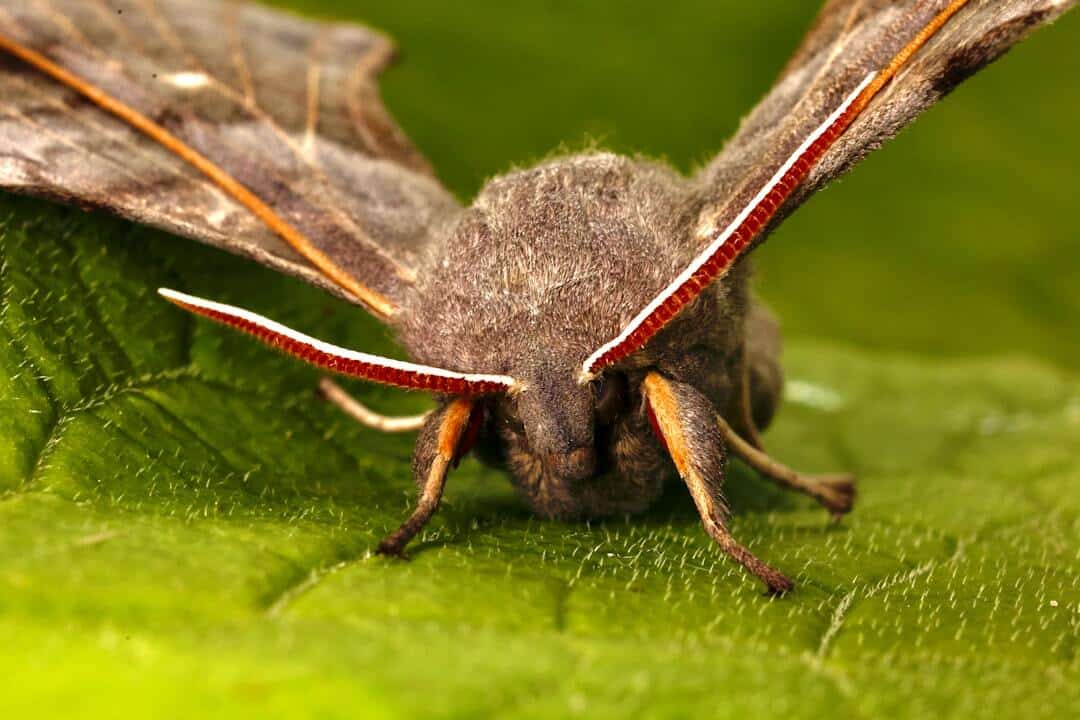
The Mothman legend began in November 1966 when five men digging a grave in a cemetery near Clendenin, West Virginia, claimed to see a man-like figure flying low over the trees. Shortly after, two couples driving near the abandoned West Virginia Ordnance Works reported encountering a large gray creature with glowing red eyes and enormous wings. Over the next year, similar sightings were reported by over 100 local residents, describing a being 7 feet tall with a 10-foot wingspan and hypnotic red eyes that caused witnesses to experience extreme anxiety and psychological distress.
The Mothman sightings culminated with the collapse of the Silver Bridge on December 15, 1967, which killed 46 people. Many connected the Mothman to this tragedy, suggesting it had appeared as a warning or omen of the impending disaster. Since then, similar sightings have been reported before other catastrophes worldwide. Skeptics suggest the original Mothman sightings might have been misidentifications of large birds like herons or owls, or possibly even large owls with eye-shine reflecting car headlights. The legend has become deeply embedded in American folklore, inspiring books, films, and an annual festival in Point Pleasant, West Virginia, where a statue of the creature stands in the town center.
The Wendigo Cannibalistic Spirit of the North
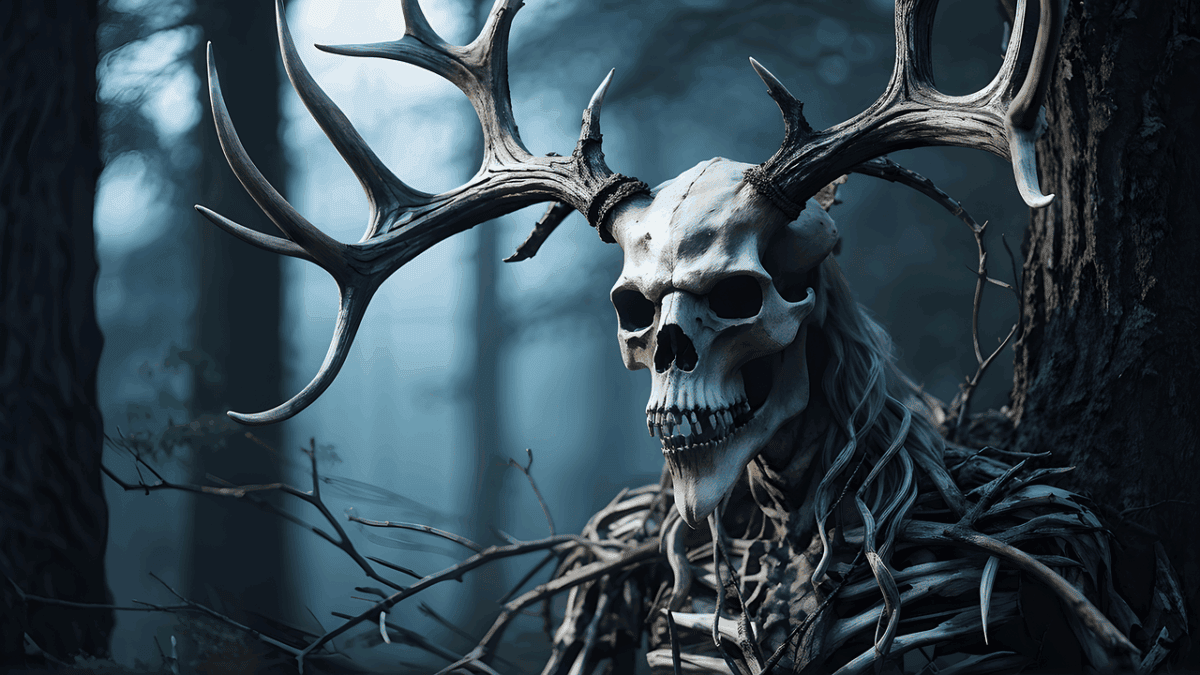
The Wendigo originates from the folklore of Algonquian-speaking tribes of the northern forests of Nova Scotia, the East Coast of Canada, and Great Lakes Region. Unlike many other creatures in American folklore, the Wendigo represents a deeply spiritual and moral concept. Described as a gaunt, emaciated creature with ash-gray skin stretched over bone, glowing eyes, and deer antlers, the Wendigo was believed to possess humans who engaged in cannibalism during the harsh winter months when food was scarce.
In traditional Native American belief, the Wendigo embodied the taboo against cannibalism and represented the dangers of greed and excess. The creature was said to grow in proportion to each meal, ensuring it remained perpetually hungry regardless of how much it consumed—a metaphor for insatiable greed. Psychologists have identified “Wendigo psychosis,” a culture-bound syndrome where individuals in these tribal cultures experienced an intense craving for human flesh. While the Wendigo as a physical entity remains firmly in the realm of folklore, its cultural significance provides insight into the moral frameworks and survival challenges of northern indigenous communities, making it one of the most psychologically complex creatures in American folklore.
The Chupacabra Modern Livestock Predator

The Chupacabra, or “goat-sucker,” represents one of the more recent additions to American folklore, with the first reported sightings occurring in Puerto Rico in 1995. The creature gained its name from its reported habit of attacking livestock and draining their blood, leaving puncture wounds but little other evidence of violence. Early descriptions from Puerto Rico portrayed the Chupacabra as a reptilian creature with leathery or scaly greenish-gray skin, standing 3 to 4 feet tall, with a row of spines extending from its head to its back, and large, glowing red eyes.
As the legend spread to the continental United States, particularly Texas and the Southwest, descriptions evolved to resemble hairless canids with pronounced overbites, protruding teeth, and skin problems. Scientific investigations of “Chupacabra” corpses have consistently identified them as coyotes or dogs suffering from severe mange, which causes hair loss and skin problems that dramatically alter their appearance. The original Puerto Rican sightings coincided with the release of the science fiction horror film “Species,” which featured a similar-looking alien, suggesting pop culture influenced the development of this modern myth. Despite scientific explanations, the Chupacabra has firmly established itself in contemporary folklore, particularly in Latino communities across the Americas.
The Jackalope Western Trickster
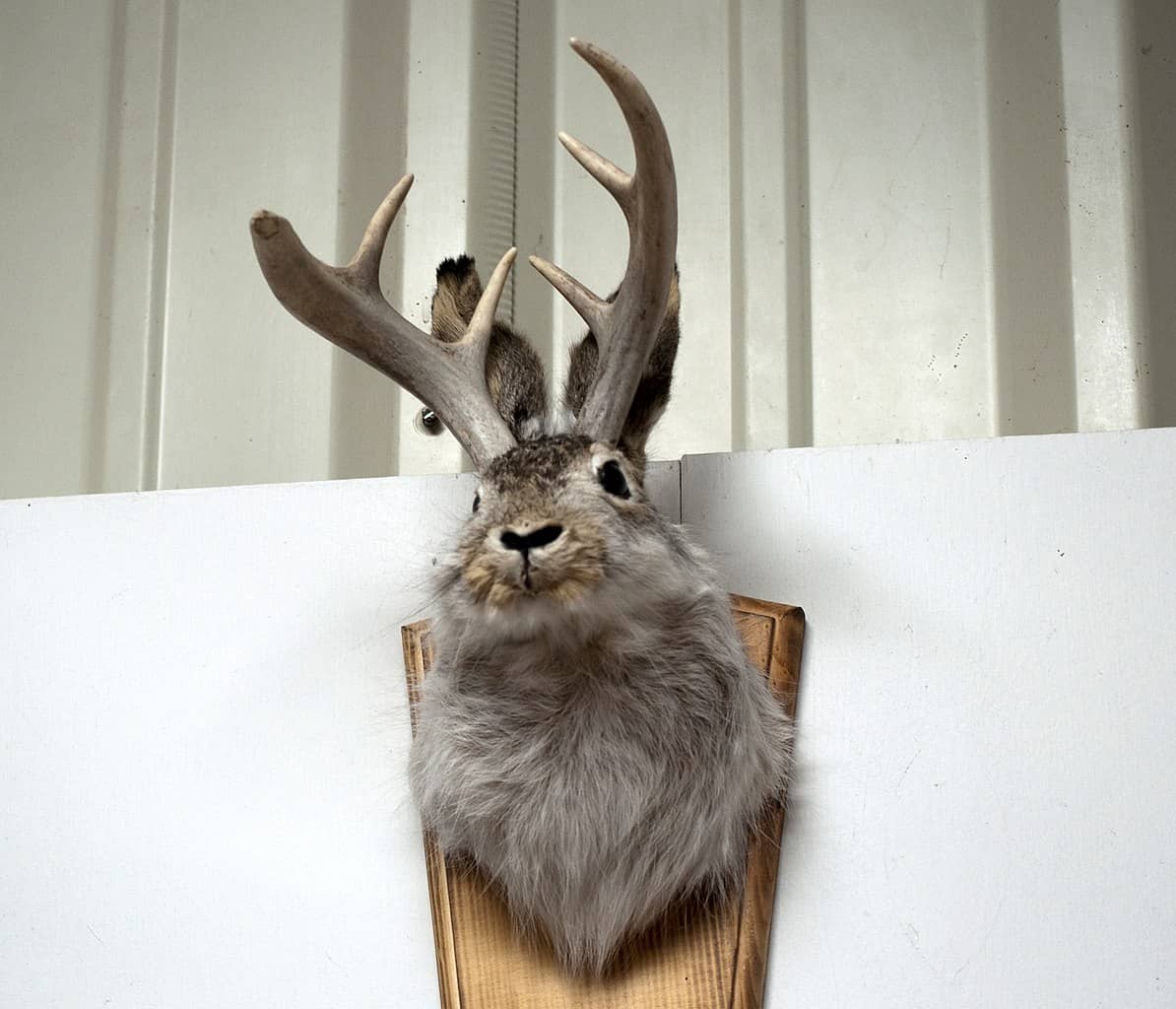
The Jackalope—a jackrabbit sporting antelope horns—represents one of the more whimsical creatures in American folklore. Unlike many other cryptids that inspire fear or awe, the Jackalope embodies the tall-tale tradition of the American West, where frontier humor often involved outlandish exaggerations. The modern legend is largely attributed to Douglas Herrick of Douglas, Wyoming, who in the 1930s created the first Jackalope taxidermy mount by attaching deer antlers to a jackrabbit carcass. This creative taxidermy became a popular novelty item and tourist attraction throughout the West.
While clearly fictional, the Jackalope myth was elaborated with humorous details: they were said to be able to mimic human voices to confuse cowboys, could only be caught when thunderstorms approached, and produced milk that had medicinal properties. Interestingly, the Jackalope may have a basis in reality—rabbits infected with the Shope papilloma virus develop horn-like growths on their heads and faces that can resemble antlers. Native American rock art depicting horned rabbits predates European settlement, suggesting the concept may have deeper roots than the 20th-century novelty. Today, the town of Douglas, Wyoming celebrates itself as the “Jackalope Capital of the World,” complete with a giant Jackalope statue and an annual Jackalope Day festival, demonstrating how even acknowledged fictional creatures can become meaningful cultural symbols.
The Hodag Lumberjack Legend
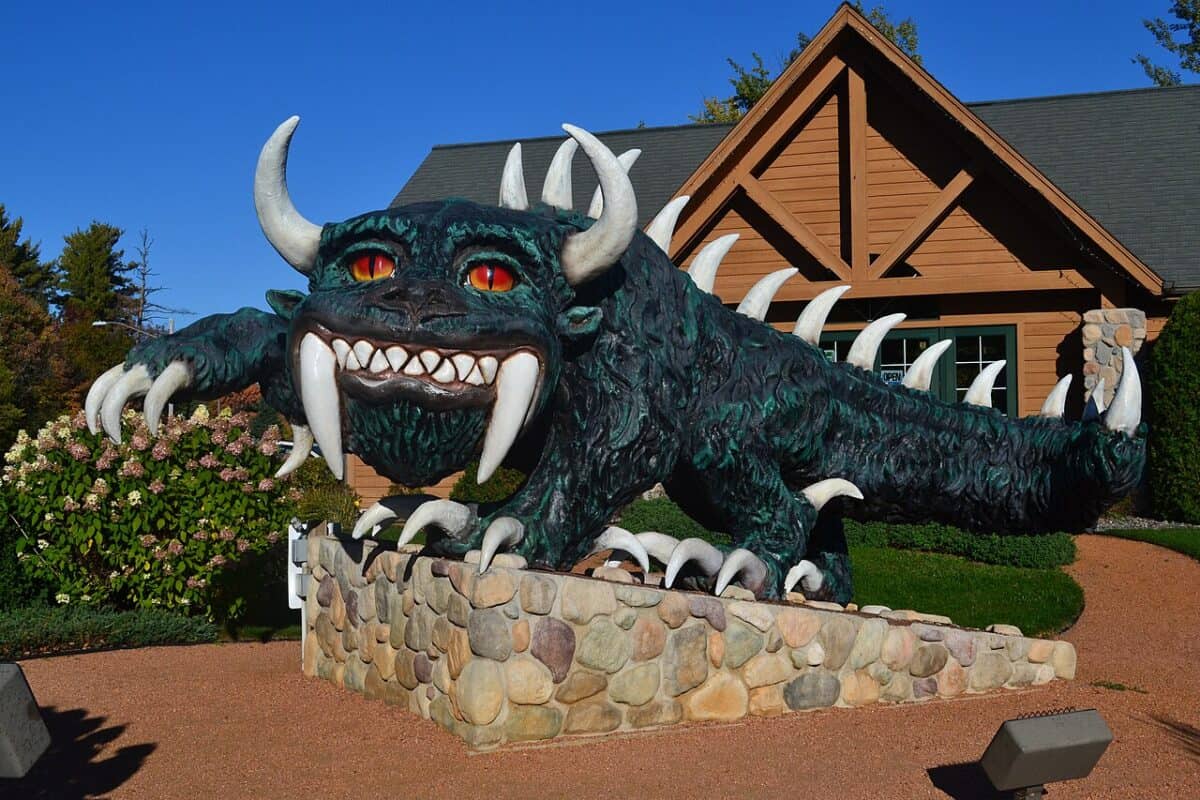
The Hodag emerged from the logging camps of Wisconsin in the late 19th century, specifically associated with the town of Rhinelander. First described by logger and prankster Eugene Shepard in 1893, the Hodag was said to be the incarnation of the spirits of deceased oxen that had been abused by their handlers. Shepard described the creature as having “the head of a frog, the grinning face of a giant elephant, thick short legs set off by huge claws, the back of a dinosaur, and a long tail with spears at the end.”
Shepard’s hoax reached its peak when he claimed to have captured a live Hodag using dynamite. He displayed the “captured” beast (actually constructed of wood and ox hides with cattle horns) to paying audiences who viewed it from a distance in a dimly lit tent. When scientists from the Smithsonian Institution announced plans to examine the specimen, Shepard admitted it was a hoax. Despite its fictional nature, the Hodag became a beloved symbol of Rhinelander’s logging heritage and the tall-tale traditions of lumber camps. Today, Rhinelander embraces the Hodag as its official symbol, featuring the creature on the city’s welcome sign, as the high school mascot, and in an annual festival. The Hodag represents how acknowledged hoaxes can transform into cherished cultural identities that celebrate regional history and humor.
The Altamaha-ha Georgia’s River Monster

The Altamaha-ha, affectionately known as “Altie,” is Georgia’s answer to the Loch Ness Monster—a serpentine creature said to inhabit the waters of the Altamaha River. According to legend, the Altamaha-ha has been sighted from Darien to as far upstream as Lumber City, Georgia. Native American tribes of the region, including the Creek and Tama, had legends of a giant snake-like creature inhabiting the river long before European settlement. Descriptions typically portray Altie as 20 to 30 feet in length with a dolphin-like body, a seal-like head, and flippers rather than fins.
Unlike some cryptids surrounded by extensive hoaxes or commercial exploitation, the Altamaha-ha has maintained a relatively low profile in national cryptozoology circles while remaining significant to coastal Georgia’s folklore. Scientists suggest sightings might be explained by large fish such as sturgeon (which can grow over 8 feet long), manatees that occasionally venture into the river from the coast, or floating logs and debris moving with the current. Some cryptozoologists have proposed the creature could be a surviving prehistoric marine reptile, though no physical evidence supports this theory. Today, the town of Darien embraces Altie as a local mascot with statues and souvenirs, demonstrating how regional water monsters often become symbols of local identity and connections to indigenous heritage.
The Skunk Ape Florida’s Swamp Sasquatch
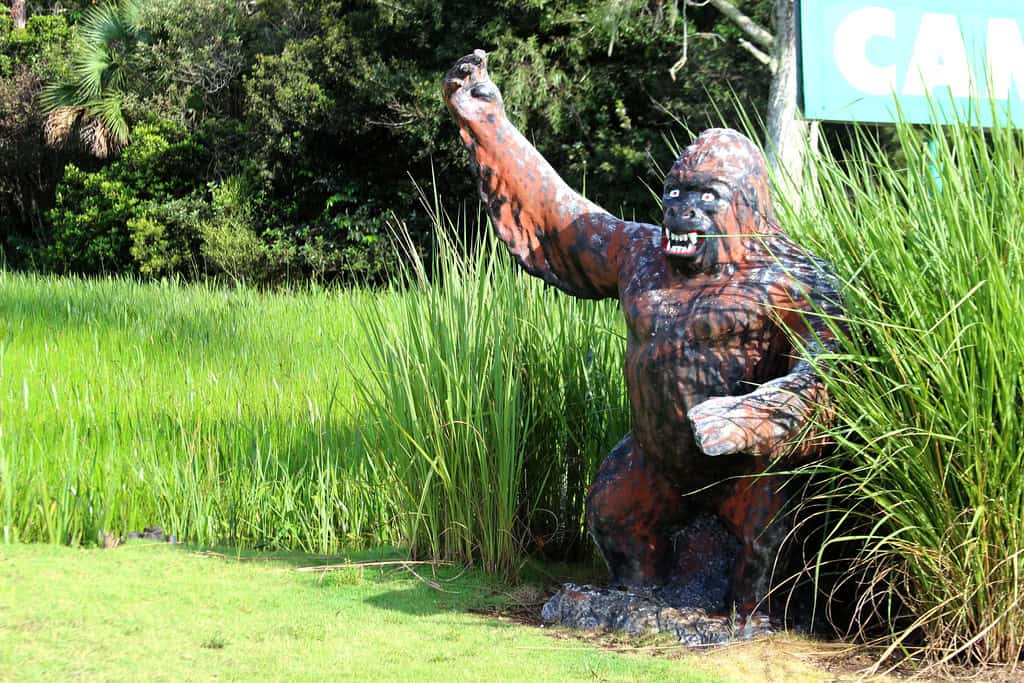
The Skunk Ape, sometimes called the Swamp Cabbage Man or Stink Ape, is Florida’s variant of the Sasquatch legend, adapted to the subtropical environment of the Everglades and surrounding swamplands. Described as a large, hairy, bipedal humanoid standing 5 to 7 feet tall, the Skunk Ape earned its colorful name from the distinctive foul odor witnesses report smelling during encounters. This smell has been compared to rotten eggs, methane, or a combination of skunk spray and garbage, and is often the first indication of the creature’s presence before visual confirmation.
Sightings increased dramatically in the 1960s and 1970s in rural parts of Florida, particularly Dade, Broward, and Collier counties. In 2000, an anonymous envelope was delivered to the Sarasota Sheriff’s Department containing photographs of what appeared to be an ape-like creature in the underbrush, now known as the “Myakka photos.” Skeptics suggest Skunk Ape sightings could be misidentifications of black bears, escaped great apes, or humans living off the grid in remote areas. The distinctive odor associated with the creature might be explained by natural swamp gases or the animal’s contact with stagnant water and decaying vegetation. Despite scientific skepticism, the Skunk Ape has become a beloved part of Florida folklore, with dedicated research centers and tourist attractions keeping the legend alive.
The Pope Lick Monster Kentucky’s Deadly Trickster
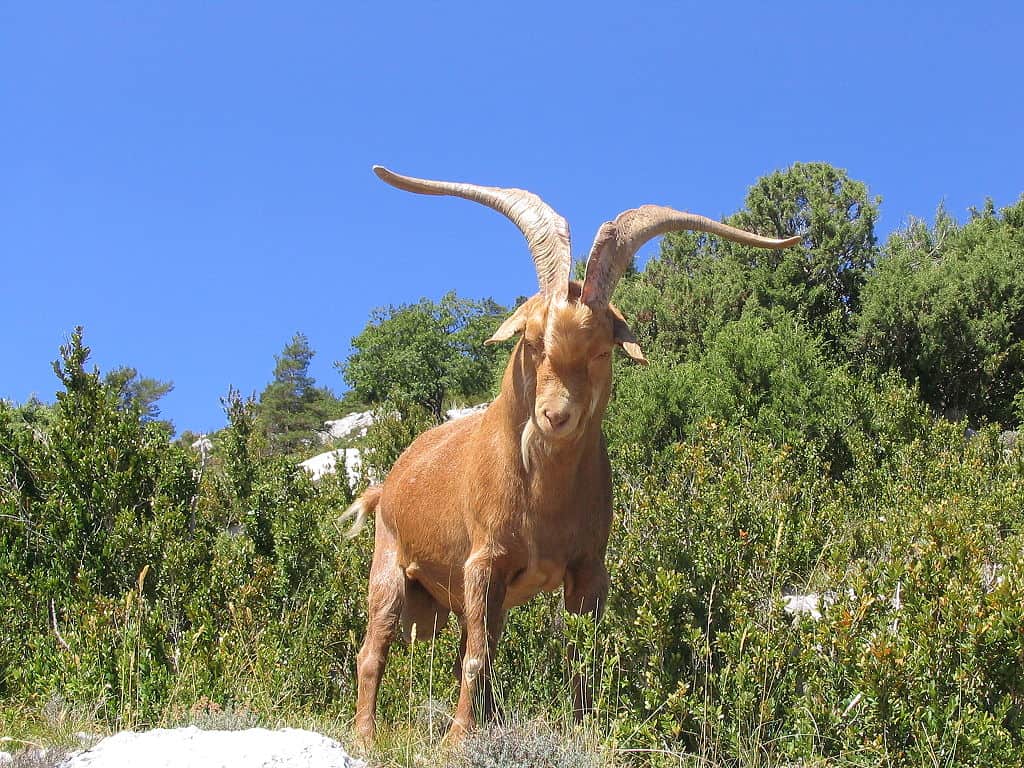
The Pope Lick Monster, named for the Pope Lick Creek and trestle where it allegedly dwells in Louisville, Kentucky, represents one of the darker legends in American folklore. Described as a human-goat hybrid with a man’s torso, goat legs, and a horned head (similar to ancient depictions of the god Pan or satyrs), the creature is said to use hypnosis, voice mimicry, or some form of mind control to lure victims onto the railroad trestle. Once there, people are either pushed to their deaths, attacked directly, or trapped until an oncoming train arrives.
Unlike many cryptids whose legends remain relatively harmless, the Pope Lick Monster legend has resulted in actual tragedies. Multiple deaths and injuries have occurred when thrill-seekers accessed the dangerous railway trestle in search of the monster, leading to fatal encounters with trains. Local origin stories vary, with some claiming the creature is the deformed offspring of a farmer and his livestock, while others suggest it escaped from a circus train wreck or is the reincarnated spirit of a farmer who sacrificed goats to Satan in exchange for power. The Pope Lick Monster serves as a sobering reminder of how folklore can have real-world consequences, particularly when it encourages dangerous behavior in vulnerable populations like teenagers seeking thrills or attempting to prove their courage.
The Loveland Frog Ohio’s Amphibian Humanoid

The Loveland Frog (or Loveland Lizard) legend centers around sightings of a 3 to 4-foot-tall humanoid frog or reptilian creature in the vicinity of Loveland, Ohio. The first documented encounter occurred in May 1955, when a businessman claimed to have seen three frog-faced men gathered under a bridge. He described them as having wrinkled skin, webbed hands and feet, and frog-like faces. The legend gained additional credibility in 1972 when two Loveland police officers, Ray Shockey and Mark Matthews, reported separate encounters with a similar creature.
Officer Shockey claimed to have spotted the creature crossing the road, describing it as 3 to 4 feet tall with leathery skin, weighing about 50 to 75 pounds, and having the face of a frog or lizard. Two weeks later, Officer Matthews reportedly encountered the same creature and even fired a shot at it, though he later recanted his story, suggesting what he saw was likely a large iguana that had escaped from its owner. Some cryptozoologists have connected the Loveland Frog to Native American legends of river demons, while skeptics point to misidentifications of mundane animals like large bullfrogs, snapping turtles, or monitor lizards. Despite the contradictory evidence, the Loveland Frog has become a beloved local legend, inspiring everything from musical productions to craft beer names, demonstrating how even debunked cryptids can become important elements of local cultural identity.
Conclusion:

America’s folklore is rich with mysterious creatures that blur the lines between myth and reality. From Bigfoot in the Pacific Northwest to the Jersey Devil in the Pine Barrens, these legends reflect regional fears, cultural storytelling, and the deep human desire to explain the unknown. While some of these creatures may be rooted in sightings of real animals or misidentified natural phenomena, others remain firmly in the realm of legend—fueling curiosity, local pride, and even tourism.
Whether fact, fiction, or something in between, these creatures continue to capture the imagination of generations. Exploring their stories helps preserve cultural history while reminding us of nature’s wonder and unpredictability. In the end, it’s not always about proving whether these beings exist—it’s about understanding what they represent to the people who believe in them.
- 10 Amazing Animals You Can See in Canada - August 10, 2025
- California Has a Salamander So Tiny It Fits on Your Fingertip - August 10, 2025
- 13 Creatures That Did Not Exist 100 Years Ago - August 10, 2025

